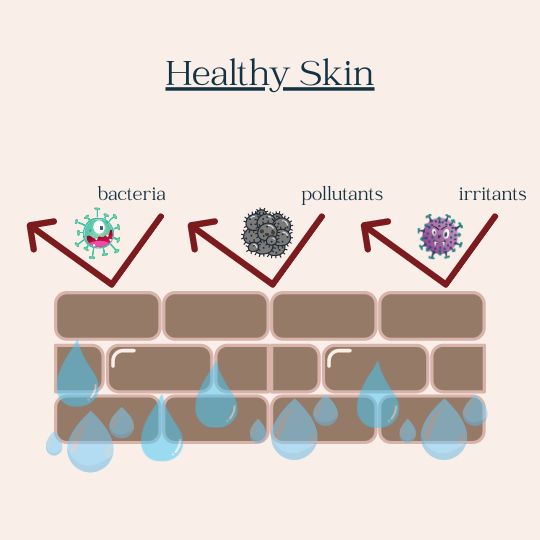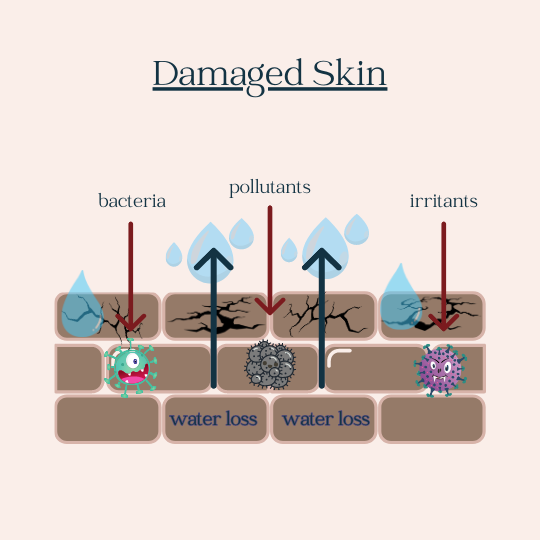Beginner’s Guide to Skincare -Part 2
Facial Moisturizers
Your skin, the body's largest organ, is a remarkable marvel of nature, performing the essential task of protecting you from pollution, UV rays, and other external factors. To navigate the numerous lotions and creams available, it's important to understand the underlying science of your skin's structure and function. By delving into the intricacies of dermatology, we can identify those key ingredients and formulations that harmonize with your skin's natural physiology, enhancing its health, appearance, and resilience.
Let’s first look at the actual products themselves. It’s helpful to understand the difference between creams and lotions so you can make an informed decision when choosing a product.
Cream
Consistency: Creams for the face are usually thicker, with a higher concentration of oils and butters with less water content.
Moisturizing Effect: Rich in emollients, creams provide intense hydration and form a protective barrier that helps lock in moisture.
Best For: Creams are suitable for dry, mature, or sensitive skin types that require deeper hydration and nourishment.
Use: Often used as night creams or in colder weather to provide extra moisture.
Feel: They tend to feel richer and may take a little longer to absorb into the skin.
Lotion
Consistency: Facial lotions are more lightweight, with a higher water content and less oily feel.
Moisturizing Effect: While lotions do provide hydration, they are typically less intensive than creams.
Best For: Lotions are suitable for normal, combination, or oily skin types and can be used daily without feeling heavy.
Use: Ideal for daytime use or in warmer weather, as they absorb quickly and leave the skin feeling fresh.
Feel: They are often preferred for a lighter, non-greasy feel and can be an excellent base for makeup.
The primary differences between facial creams and lotions lie in their consistency, moisturizing effect, and suitability for different skin types. Creams are generally richer and more nourishing, making them suitable for those seeking intensive hydration, while lotions offer a lighter, more refreshing option, ideal for daily wear and oilier skin types.
Choosing between a cream and a lotion for facial care should align with your skin's specific needs, the climate, and your preferences in texture and feel.
What Makes Skin a Barrier?
It seems like we’re hearing about the skin barrier everywhere if you’re into skincare! So, what actually is the Skin Barrier and why does taking care of it matter?
The skin has a special layer called the stratum corneum (SC) that acts like a wall. This wall does two major things:
Protection: It acts like a shield, keeping harmful substances like bacteria and environmental pollutants out while keeping essential moisture in.
Moisture Retention: By holding in water and natural oils, it keeps the skin hydrated, soft, and supple.
Key Components of the SC are:
Lipids: These are natural fats found in the skin, including ceramides, cholesterol, and fatty acids. They fill the gaps between skin cells, acting like mortar in a brick wall.
Skin Cells: The "bricks" of the wall, these are skin cells at the end of their life cycle that are tightly packed together.
A healthy skin barrier keeps your skin looking smooth and feeling soft and hydrated. A damaged skin barrier leads to dry, irritated, irregularly textured, and acne prone skin. It's like having cracks in a wall, allowing moisture to escape and irritants to enter.
The best way to take care of your skin barrier is:
Moisturizer: Using moisturizers with ingredients like ceramides and hyaluronic acid helps reinforce the barrier.
Avoid Harsh Products: Over-cleansing or using harsh products can strip away the natural oils, weakening the barrier. Even for acne prone skin, oil cleansing is the gentlest way to cleanse your skin.
Sun Protection: Wearing sunscreen helps protect the barrier from UV damage. Always use SPF, even in the winter, even if it’s cloudy. NO EXCUSES!!!
Components of a Moisturizer
Moisturizers come into play by helping the skin become softer and more elastic. They should contain ingredients that match what's found in the skin's natural barrier, known as skin identical or biomimetic ingredients. There are many synthetic versions of these ingredients but, if plant-based, healing ingredients are important to you then try to stick with products that list similar ingredients to the types listed below.
Triglycerides: Triglycerides are fats that can be found in many oils and butters, providing moisturizing and softening benefits. Sources include coconut oil and medium chain triglycerides (MCT, derived from coconut oil), avocado oil, shea butter, and some really interesting butters and oils that we will go into later.
Squalane: Squalane is a highly regarded ingredient in skincare, known for its emollient properties and compatibility with various skin types. There is a controversial source from shark fins, known as squalene that I prefer to stay away from. Plant based sources are from olives, sugarcane, and rice bran, providing an ethical and sustainable option.
Ceramides: Ceramides are crucial for maintaining the skin's barrier and preventing moisture loss. They can be found in ingredients like wheat germ oil, which is rich in natural ceramides, konjac root containing a form of ceramides called glucomannan, and there are even some beautiful synthetic ceramide complexes that closely mimic the skin’s natural ceramides.
Cholesterol: Cholesterol is an essential component in skincare as it plays a vital role in maintaining the skin's barrier function and elasticity. While plants don't contain cholesterol, some sources provide phytosterols, which are plant-based compounds that are structurally like cholesterol. They can mimic cholesterol's effects in skincare formulations. I love shea butter and sunflower oil as sources.
Phospholipids: Phospholipids are essential for maintaining skin's moisture and elasticity. Obtained from sunflowers or soybeans in the form of lecithin. Goat milk is my favorite source of phospholipids!
Fatty acids: Fatty acids play a crucial role in skincare, providing moisturizing and nourishing benefits. They can be found in various oils, butters, and other natural sources. I could write a complete article on fatty acids alone (and I might)! My favorite sources are from oils that contain high linoleic acid like sunflower, hemp seed, and evening primrose oils. Some butters I love for skin are bacuri, murumuru, mango, and shea.
If you prioritize natural skincare, you’ll want to seek out products formulated with plant-based and biomimetic ingredients. While many synthetic versions of these compounds exist and can be effective, those who value natural and botanical sources may prefer to choose products that specifically list plant-derived ingredients on their labels. This approach aligns with a holistic skincare philosophy and supports the selection of products in harmony with nature.
What about Hydration?
A good moisturizer can have a significant impact on TEWL or Trans-epidermal water loss, which describes how much water escapes from the skin. If the skin is injured or damaged, this balance is thrown off, making the skin's function suffer. Balanced hydration and reduction of TEWL is vital to your skin’s overall health.
Our skin must hold enough water to work properly. The balance of moisture depends on:
The air's humidity.
The skin's ability to hold water.
How fast water moves through the skin.
How long it takes for water to reach the top skin layer.
A great moisturizer will have numerous benefits for your skin. It will not only have the beneficial ingredients we have discussed but will contain hydrating ingredients such as:
Hyaluronic Acid: Hyaluronic acid is a powerful humectant that can hold up to 1,000 times its weight in water. It binds to water molecules, drawing moisture into the skin's layers. You do want to be careful when applying HA, ensure you apply the product to slightly damp skin because it can begin to pull moisture out of the skin rather than the atmosphere. This is an issue that can be addressed through proper occlusives in the product formulation.
Glycerin: Glycerin is also a humectant and helps keep the skin hydrated and moist, preventing dryness and flakiness.
Your moisturizer should also contain occlusives that will help seal in moisture and minimize the evaporation of water. Many of the butters we have covered will be occlusive agents. You will also want to look for healing ingredients like aloe vera and allantoin. Lastly, you want your moisturizer to have active ingredients that will support the skin’s natural functions. Ingredients like antioxidants will protect your skin from pollution and help to boost the effectiveness of your SPF. Vitamin components will have beneficial effects as well such as brightening or smoothing. Your moisturizer can work in tandem with other skincare products that target your specific skin concerns.
Final Thoughts on Choosing the Right Moisturizer
I hope this information helps clear up how to pick the right moisturizer for your skin. One of the first steps is understanding how your skin works. By taking some time to read the ingredients and selecting products with ingredients that mimic the skin's natural components, you can maintain a healthy, glowing complexion. Embrace the science of skincare and nourish your skin with the love it deserves!
Frankly Face Frankincense Cream: A Closer Look
Fresh Goat Milk: Serves as a multifunctional ingredient with the ability to exfoliate, hydrate, brighten, and rejuvenate the skin.
Frankincense Hydrosol & Essential Oil: Renowned for its rejuvenating and anti-aging effects.
Aloe: Adds hydration, nourishment, and soothes irritated skin.
Jojoba Oil, Sunflower Seed Oil: Provide important fatty acids to the skin. ****
Bacuri & Murumuru Butters: Emollient and Occlusive, these butters provide lipid hydration and help seal moisture into the skin. Bacuri butter also contains Lysine. Along with its role in collagen production helping to reduce the appearance of fine lines and wrinkles, lysine's ability to aid in repairing damaged skin makes it an essential component in Frankly Face.
Ceramide Complex & Hyaluronic Acid: Mimics skin's natural components.
Glycerin & Lecithin: Enhances moisture retention.
Vitamin E: Acts as antioxidant.
Allantoin: Allantoin acts as an emollient, softening and smoothing the skin's texture. It helps the skin retain moisture, making it feel more hydrated and less dry.
These ingredients align perfectly with what's needed to maintain a healthy and vibrant skin barrier.



